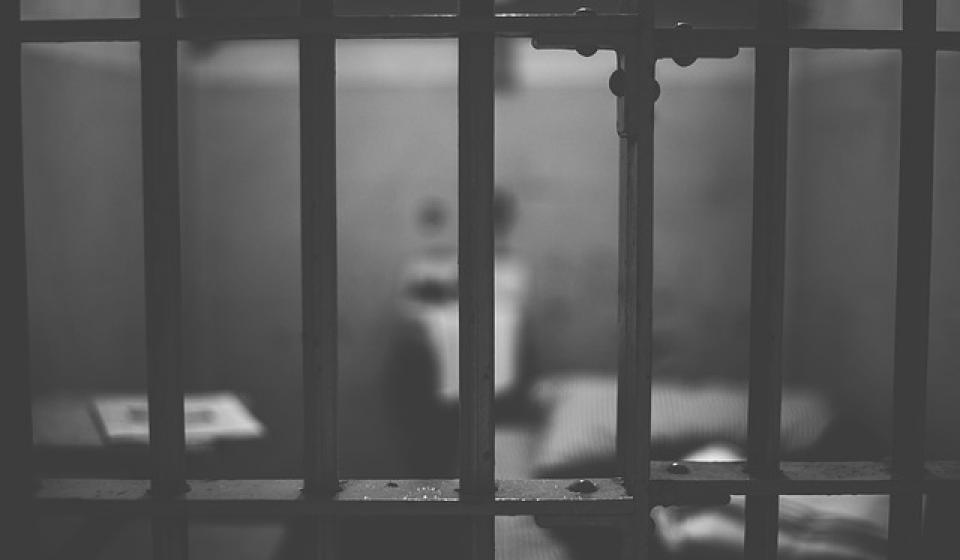“War costs us everything and resolves nothing.”

Photo by AlexVan
These were men Kate Edwards knew well. They had attended the spiritual talking circles she ran as a Buddhist chaplain in Wisconsin prisons. Some of them ended up in solitary confinement.
“They would start to change in disturbing ways,” recalls Edwards, who continued to have contact with several of these inmates—now through a glass partition, as they sat with handcuffs and leg shackles. “They became unkempt, less able to focus. As the weeks went by, they would look more and more distressed. I was watching them disintegrate.”
One man she knew stopped eating. Another, while serving a maximum 360-day term in solitary, attempted suicide. In response, she says, he was punished with an additional 360 days in the hole.
Edwards, a member of a faith-based prisoner advocacy group called Wisdom, helped write a report on the use of solitary confinement in Wisconsin. The group has used a life-sized replica of a six-by-twelve-foot solitary cell, with a recording of the deafening racket made by prisoners within an actual solitary unit, to drive home the harsh realities of this form of incarceration to thousands of people, in churches and public places. (A national group in Washington, D.C., has made its own replica.)
It’s been a lonely battle, with intractable bureaucracies on one side and a largely indifferent public on the other. But now, at long last, there are hopeful signs.
“Do we really think it makes sense to lock so many people alone in tiny cells for twenty-three hours a day, for months, sometimes for years, at a time? That is not going to make us safer. That is not going to make us stronger. And if those individuals are ultimately released, how are they ever going to adapt?”
These words were spoken in mid-July by President Obama, at the NAACP convention in Philadelphia. They echo remarks made in March by U.S. Supreme Court Justice Anthony Kennedy, who flatly declared: “Solitary confinement literally drives men mad.”
Of course it does. This has been known for years. Inmates in solitary are locked down in tiny cells, with nothing to do. They face crushing depression and anxiety. They scream and cry. They slash and bite their own flesh. They smear feces on the walls. They try to kill themselves with pens, with paper clips, with bed sheets, with the metal from their glasses. If they survive, they are often punished some more.
Amnesty International calls the way solitary is used in the United States “a breach of international law.” A United Nations official has said the use of solitary for more than fifteen days may constitute torture, causing “harmful psychological effects [that] can become irreversible.” A U.N. commission, with support from the United States, approved rules in May banning the prolonged use of solitary (defined as more than fifteen days); the measure now heads to the General Assembly.
Meanwhile, hundreds of inmates in U.S. prisons have served years on end in solitary. A 2013 survey by the Association of State Correctional Administrators garnered length-of-stay information from eighteen states. It found these states collectively had 3,100 inmates held continuously in segregation for more than one year, including 200 in the hole for more than ten years.
There are currently an estimated 75,000 U.S. prisoners in solitary confinement, most in state prison systems. In recent years, there has been slow progress toward reducing the use of this form of extreme isolation. More than a dozen states have pursued new policies, like banning the use of solitary for juveniles or inmates with mental illness.
New York State has ended the use of solitary confinement to discipline prisoners under eighteen. Arizona, in response to a lawsuit, has expanded mental-health treatment options for inmates in solitary. New Mexico has banned the use of solitary for juveniles, mentally ill inmates, and for periods of longer than fifteen days.
In Colorado, the number of inmates in solitary was slashed from about 1,500 in 2011 to about 150 by mid-2015. Rick Raemisch, head of that state’s prison system, has testified before Congress that solitary confinement is “overused, misused, and abused.” Raemisch’s predecessor, Tom Clements, was murdered in 2013 by an inmate who was released directly from solitary into the community.
“Whatever solitary confinement did for that former inmate and murderer, it was not for the better,” Raemisch, a former Republican sheriff, has written. Raemisch told me in an interview that the wholesale use of solitary showed how corrections has “lost sight of its mission” to rehabilitate inmates before they are returned to their communities.
“You can’t give up on trying to make them better,” Raemisch said, “because if you do give up, you’re going to make them worse.”
Solitary confinement breaks people. It breaks their spirit and breaks their mind. It does so predictably, and by design. It dehumanizes them, as well as their captors.
In 2014, I wrote a three-day series that ran in more than a dozen papers in Wisconsin. It focused on a particular solitary unit in the state’s oldest prison: Waupun Correctional Institution. It documented forty separate allegations of abuse involving thirty-three inmates, over a three-year period. Two-thirds of these allegations involved a single guard: Joseph Beahm.
Beahm has been accused of abusing inmates in countless internal complaints and at least a dozen federal lawsuits. Most of these lawsuits have been rejected by judges; two suits were lost after jury trials. One case was dismissed because the inmate, Marcus Childs, missed a filing deadline. He had a good excuse, having hung himself to death in his cell.
Records obtained during the course of a five-month investigation confirmed the routine use of force against inmates in seg, involving tasers, pepper spray, knee strikes, “wall slams,” and other measures. All were described as necessary responses to inmate behavior. In no case were guards disciplined; in many cases, inmates were.
One inmate, Leighton Lindsey, testified in court that he bit a correctional officer in late 2011 in self-defense. He said the officer was holding him down while Beahm was beating him. Beahm’s report of the incident states that Lindsey was subdued with “strong side knee kicks and strong side forearm strikes.” Lindsey received a bloody gash across his forehead, a photo showed, and ultimately agreed to a plea bargain for biting the guard that added a year to his sentence.
In the three months prior to the biting incident, Lindsey filed at least five internal complaints accusing Beahm of harassment and threats, as other inmates have done. “He is a rogue guard, and you all know it,” he wrote in one complaint. “Everybody can’t be lying on this guy.” All of Lindsey’s complaints were dismissed.
A former inmate, Talib Akbar, wrote a letter to the Waupun warden in 2012 complaining that he watched Beahm throw a handcuffed inmate face-first to the floor, pin him down with a knee, and yank his head back. He noted that Beahm “has a habit of this kind of abuse.” The complaint went nowhere.
“It’s a psychological warfare environment,” said former Waupun inmate Marvin Smith, who spent most of his seven years at the prison in solitary, which in Wisconsin is called segregation. “They know which inmates are weak. They know which inmates they can prey upon.” Smith claims he heard Beahm taunt Childs during a prior unsuccessful hanging attempt, before cutting him down: “There you go! Ah, ah, ah, a little bit more! You can do it. Come on!”
University of Wisconsin law professor Walter Dickey, the former head of the Wisconsin prison system, said segregation “brings out the worst in everybody. You’ve got a structure that starts a human dynamic between people that’s destructive.” He cautioned against allowing guards to work in solitary for extended periods.
Wisconsin prison officials confirm that Beahm, who has not responded to requests for comment, remains assigned to the segregation unit at Waupun, along with another guard named in multiple complaints. Several other guards named in multiple complaints have been promoted.
Brian Cunningham, a Waupun correctional officer who heads the union that represents state prison workers, denied to me that abuse of inmates by guards is prevalent. But he affirmed that working in solitary is “an incredibly difficult job to do,” in part because the conditions for inmates are so bleak.
“You know, he doesn’t come out,” he said. “He’s stuck in a cell the size of your bathroom. His bed is made out of concrete. His toilet is bolted to the wall. There is nothing good about seg.”
Undeniably, the nation’s courts have been actively complicit in perpetuating the horrors that go on in solitary.
Last September, a three-member panel of judges for the Seventh Circuit of the U.S. Court of Appeals tersely upheld a district court’s dismissal of a lawsuit brought by five Wisconsin inmates with diagnosed mental illnesses. The inmates challenged, as the panel described it, “harsh segregation conditions that exacerbated their mental health issues, causing them to attempt suicide, engage in other acts of self-harm, and develop medical problems.”
Judge Richard Posner and his two colleagues couldn’t find a problem with this. They concluded there was “no evidence that the defendants believed the conditions of confinement inappropriate for inmates suffering serious mental illness or for these plaintiffs in particular.” They also deemed the conditions of their confinement, including “two showers and four hours of outside recreation each week,” are not unconstitutional.
Posner and his colleagues also refer in passing to segregation as “nonpunitive.” But Wisconsin’s disciplinary code for inmates explicitly prescribes lengths of stay in segregation as punishment for certain offences.
In April 2014, Edward Wall, the head of Wisconsin’s Department of Corrections, wrote an article to staff noting that one state prison security director “approved sending an inmate to segregation for 180 days for having kitchen spices in his cell.” The same security director was tossing inmates in the hole for not taking their medications—180 days for a first offense, 360 days for a second.
“How do any of these things have to do with the safety and security of the institution?” Wall asked. Or, as he put it in a memo written about the same time: “Are we placing inmates in segregation because we are mad at them?”
The State of Wisconsin, under Wall, is making modest steps to reducing its use of solitary. The number of inmates thus confined fell from about 1,500 in mid-2014 to about 1,000 in mid-2015. New rules allow greater flexibility in imposing discipline, and new attitudes stress rehabilitation over retribution.
Such changes have come from the conscience of people within and outside the prison system. They are a small start. But for advocates like Edwards, it’s not nearly enough.
From her perspective, “Solitary is torture, and any amount of torture is unacceptable.”
Section:
Topics:
More
- Subscribe
- Featured Video
- Recent Stories
- Recent Comments
- Poetry


California professor Julian Vasquez Helig says social media can help in the fight to save education.
By Wendell Berry
Manifesto: The Mad Farmer Liberation Front
Love the quick profit, the annual raise, vacation with pay. Want more of everything ready made. Be afraid to know your neighbors and to die. And you will have a window in your head. Not even your future will be a mystery any more. Your mind will be punched in a card and shut away in a little drawer. When they want you to buy something they will call you. When they want you to die for profit they will let you know. So, friends, every day do something that won’t compute. Love the Lord. Love the world. Work for nothing. Take all that you have and be poor. Love someone who does not deserve it. Denounce the government and embrace the flag. Hope to live in that free republic for which it stands. Give your approval to all you cannot understand. Praise ignorance, for what man has not encountered he has not destroyed. Ask the questions that have no answers. Invest in the millennium. Plant sequoias. Say that your main crop is the forest that you did not plant, that you will not live to harvest. Say that the leaves are harvested when they have rotted into the mold. Call that profit. Prophesy such returns. Put your faith in the two inches of humus that will build under the trees every thousand years. Listen to carrion—put your ear close, and hear the faint chattering of the songs that are to come. Expect the end of the world. Laugh. Laughter is immeasurable. Be joyful though you have considered all the facts. So long as women do not go cheap for power, please women more than men. Ask yourself: Will this satisfy a woman satisfied to bear a child? Will this disturb the sleep of a woman near to giving birth? Go with your love to the fields. Lie easy in the shade. Rest your head in her lap. Swear allegiance to what is nighest your thoughts. As soon as the generals and the politicos can predict the motions of your mind, lose it. Leave it as a sign to mark the false trail, the way you didn’t go. Be like the fox who makes more tracks than necessary, some in the wrong direction. Practice resurrection.
Wendell Berry is a poet, farmer, and environmentalist in Kentucky. This poem, first published in 1973, is reprinted by permission of the author and appears in his “New Collected Poems” (Counterpoint).




















Add new comment